
I recently received an email posing this question:
We are teaching systematic phonics to our little ones, but we are conflicted as when to teach letter names. When and how should letter names be taught to children?”
The timing of the introduction of letter names is important, so I’ll frame my thoughts using the Goldilocks principle – not too early, not too late, but at just the right time. It is a developmental concern, rather than a grade/year- or age-related concern.
Letters are used as a code for the sounds in our speech so are meaningless without knowledge of the sounds. Any squiggle/shape could represent a sound, for example:
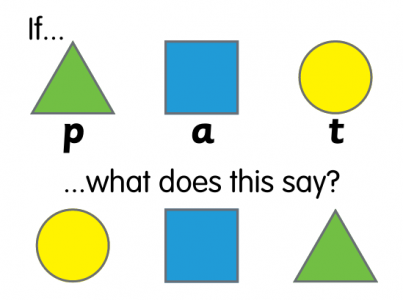 You still managed to read this with your new knowledge of our shape code!
You still managed to read this with your new knowledge of our shape code!Letter names provide abstract labels for the letters, not representations of how the letters actually sound within our language. That is why teaching a child to sing the alphabet song before the child receives formal reading instruction has limited value. The first important step towards literacy success is development of phonemic awareness and not letter name singing.
So, if letters make no sense without sounds, why not teach letter sounds and names side by side? The simple answer is because of the cognitive load. Working memory has to work hardest when a task is novel and therefore has a heavy cognitive load. For the beginning learner, identifying individual sounds in a word, from left to right, is quite a novel task. Forming letter shapes and discriminating between letter shapes are novel tasks. Remembering the name of a letter is a novel task. Linking a specific letter with a specific sound is a novel task.
Is it any wonder that some children, especially those with a weak working memory, struggle with reading and spelling? Cognitive load theory makes it clear that we can and should do what is necessary to reduce cognitive load. It is not necessary for school beginners to know the names of letters for reading and spelling, so, in my opinion, the teaching of letter names should be postponed until letter names are necessary. This allows students to begin to write and read more quickly.
Students need to learn letter-sound correspondences for reading and spelling. When a beginning reader is learning the single letter-sound correspondences, you do have to talk about the squiggles we make for sound symbols as ‘letters’, but that does not mean that you should refer to the letter names. Instead, the teacher can say:

or

When the child is spelling, the prompt can be:

Letter names will not help a child to decode words: the word ‘cat’ is not read as ‘seeaytee’. While some may argue that teachers can use aspects of letter names as cues for students to identify the sounds they represent, the potential for confusion outweighs any benefits if letter names are introduced too early.
Children learning to read who have received more instruction in letter names than letter sounds are more likely to look at a word and read:
| Letter Name | Incorrect Letter Sound |
| ‘w’ | /d/ (for ‘doubleyou’) – refers to the shape of the letter, not the sound |
| ‘y’ | /w/ (for ‘why’) |
| ‘u’ | /y/ (for ‘you’) |
| ‘c’ | /s/ (for ‘see’) – this is less common than /k/ |
| ‘g’ | /j/ (for ‘jee’) – this is less common than hard /g/ |
| ‘h’ | long /a/ (as in ‘aitch’) |
| ‘f’, ‘l’, ‘m’, ‘n’, ‘s’, ‘x’ | short /e/ (as in ‘ef’, ‘el’, ‘em’, ‘en’, ‘es’, ‘ex’) |
If they are taught letter names before letter sounds, beginning readers will expect vowel letters to represent a long vowel sound in words, reading, for example, ‘got’ as ‘goat’. The most common sound represented by a vowel letter is its short sound, and it is usually VC and CVC words, containing short vowel sounds, to which beginning readers are first exposed.
Children learning to spell who have received more instruction in letter names than letter sounds are more likely to use letter names in their spelling e.g.
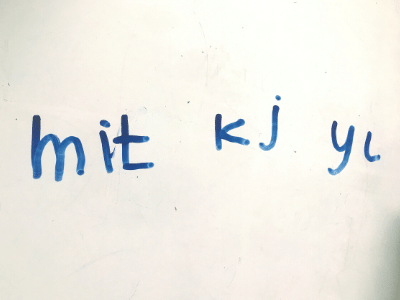 ‘Might’, ‘cage’, and ‘while’
‘Might’, ‘cage’, and ‘while’It will be harder for a teacher to help children who have not been taught letter names with their spelling. In the photo below, you can see what a five-year-old, who doesn’t know the letter names, produced when she asked how to spell ‘bean’ and the parent responded with letter names:
 “B-E-A-N”
“B-E-A-N”If a child asks how to spell the long /ee/ sound in ‘beach’, it is not appropriate to say “Write /eh/ then /ah/”, because blending those sounds together does not create the long /ee/ sound. You must use letter names e.g. “We spell the long /ee/ sound in ‘beach’ with the letter ‘e’ followed by the letter ‘a’. They make a vowel team.” Similarly, if you ask a child how ‘seek’ is spelled, it is not sufficient for the child to say “/s/, long /ee/, /k/” because there are several possible spellings for each of those sounds. Developing the language that allows discussion of letter-sound correspondences is important to reading and spelling success.
When you are helping a child to encode or decode an irregular tricky word, you need to be able to draw attention to the parts that are not regular, for example by saying “The letters ‘a’ and ‘i’ together in this word, ‘said’, are representing the short /e/ sound.” Irregular words cannot be fully sounded out so knowledge of letter-sound correspondences is insufficient.
Research indicates that letter name instruction will actually strengthen letter sound knowledge. When a student understands the way in which the alphabetic code works, letter names become important. Many letters have more than one possible sound, and many sounds can be produced by a variety of different letters, so it is important to be able to reference each letter independently of the sound it makes.
To talk about alternative spellings
Teach letter names as soon as you need to talk about alternate spellings in reading and/or spelling. Typically, the first time you need to do this will be when students learn that ‘c’, ‘k’ and ‘ck’ are all alternatives for spelling /k/. You will need to talk about where children will see these alternatives:

“We usually see the letter ‘k’ representing /k/ before an ‘e’ or ‘i’ at the beginning of a word.”
“The letter ’c’ usually represents /k/ before an ‘a’, ‘o’ or ‘u’.”
“We use the letters ‘c’ and ‘k’ together after a weak vowel at the end of a word.”
Letter names must be taught for discussion of digraphs e.g. “Because we have 44 sounds but only 26 letters in English, we have to combine some letters. The two-letter combination of ‘c’ and ‘h’ represents the sound /ch/.” When the alternative spellings of long /ee/ are taught (ea, ee, ie, ei, ey) it is no longer sufficient to just refer to ‘two-letter e’ – you must name the vowels that can be combined to represent a vowel sound, and their order.
To talk about capital letters
If you are teaching students about the use of a capital letter at the beginning of a sentence or name, you must refer to a letter name. There is no such thing as a capital sound! You will also need to refer to letter names when helping children to recognise letters when reading text in different fonts.
To communicate the spelling of a word to someone else
Familiarity with letter names allows the teacher to respond, from a distance, to the question “How do I spell the /ie/ in ‘night’?” with “It’s the i-g-h spelling”, rather than having to go and write it down for the child. When someone asks you to spell your name, do you give him/her the sounds of your name or do you provide the letter names? Of course, you give the latter. Not to do so would require the person to go through every alternative representations of the sounds and make a choice. That could take a lot of time if your name was derived from another alphabet, like ‘Siobhan’! Consequently, a teacher may have to teach specific letter names earlier to a child with a name that cannot be sounded out easily or has an unusual spelling.
To teach homophones
When the sounds of two words are the same, you must be able to describe them using their letter names. e.g. “The ‘bean’ you eat is spelled with the letters ‘e’ and ‘a’, as in the word ‘eat’. The other ‘been’ is the past tense of ‘be’ and is spelled with two e’s.”
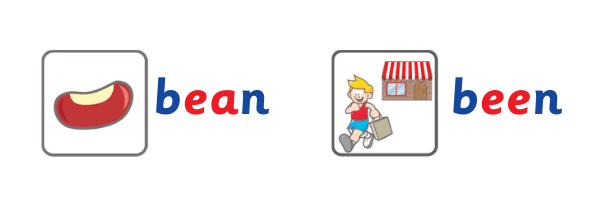
Follow the order of your synthetic phonics program in choosing which letter names to teach, when. Using our earlier example, the c/k/ck alternative spellings of /k/ are the first typically met in a synthetic phonics program (in level 6 of Phonics Hero’s Playing with Sounds order and level 2A of Letters and Sounds, so these should probably be taught first, then the letters that make up consonant digraphs (l, s, f, h, t, w, n and g).
Teach the most common letter names first, the less common letter names last (q, z, x.). Every syllable of every word must have a vowel sound and there are many alternative spellings of vowel sounds, so it is very important that students have a sound knowledge of these.
In order to have true fluency in letter recognition, children must be able to identify letters and say their names in and outside of context and in and out of sequence. It’s not just accuracy, but also automaticity, that contributes to long-term literacy success. Here are a few ideas for developing automaticity in letter naming:
Have a letter of the day and reward the child for finding that letter in the classroom, in a shared book, etc. Print our free Letter of the Day poster and use it to display the letter at the front of your classroom.
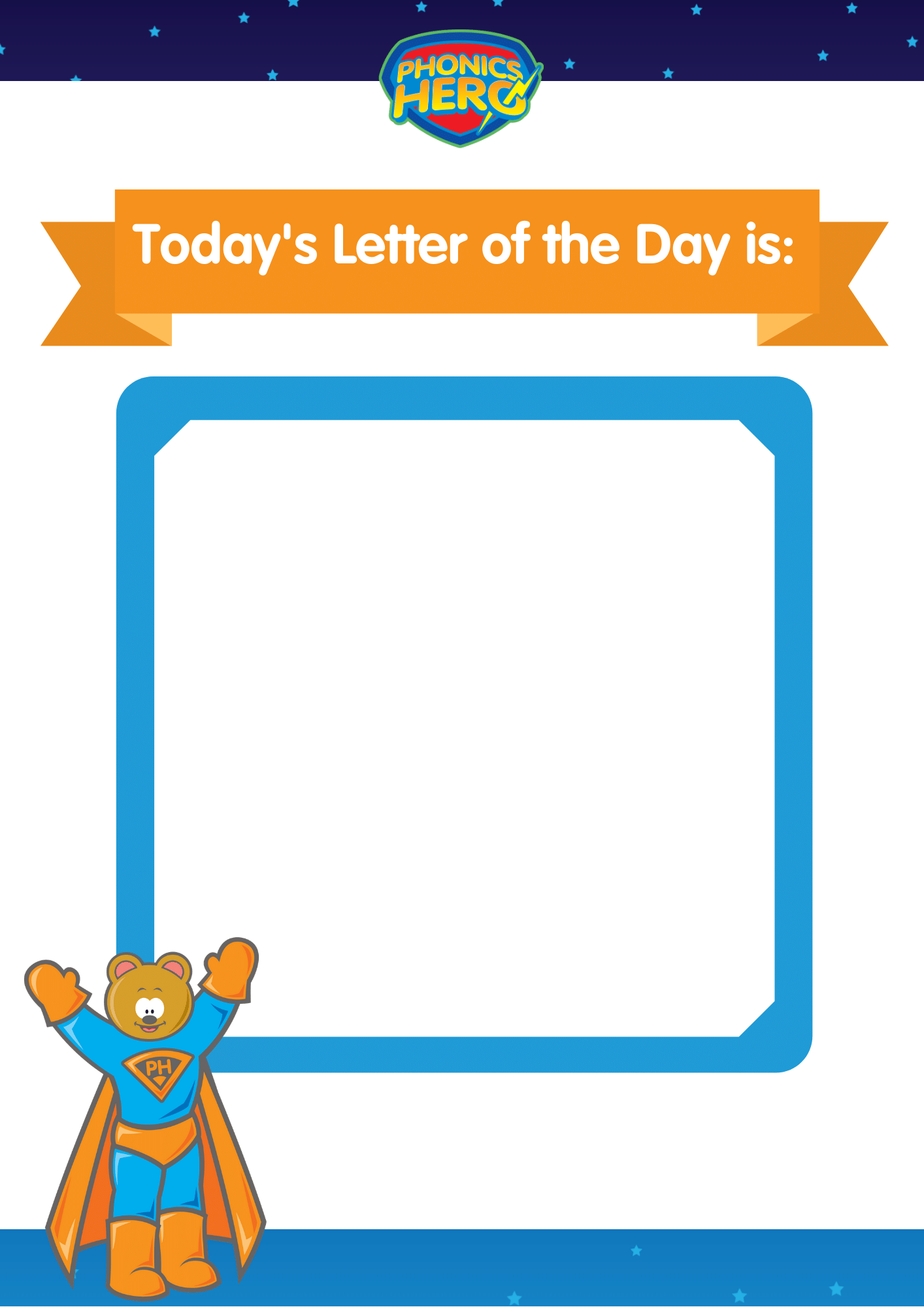
Letter searches: “Circle each letter ‘p’ in this line of letters.”
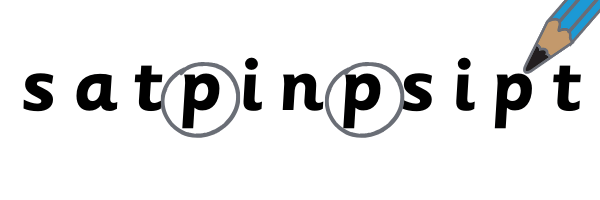
Once the student can accurately name all 26 letters, return your focus to letter-sound correspondences. There are many more sounds than letters to learn and knowledge of those correspondences are key to reading and spelling successfully!
Still have questions about how or when to teach letter names to children? Leave us a comment below!
Thank you Shirley. This is such a hot question in Western Australian teaching circles at the moment. Great to read your explanation.
Sophie – Teacher Multi Age Class 3.5yrs to 8yrs.
Thank you for this. My granddaughter, just turned three, has been playing with letters and their sounds since last April. A neighbor who is a kindergarten teacher painted an “obstacle course” on the street for the neighborhood children to enjoy. It included the alphabet in a meandering line for the children to hop on. Lately she has been absorbed with sorting — I have a big bowl of buttons, shaped like letters. I’d say she knows more than half of the letter names, and quite a few consonant sounds. It’s all play, not teaching. She’s still in the scribbling phase of writing development, but I’ll keep your advice about writing the letters when her fine motor control develops enough to be able to enjoy writing.
We’re so glad you found the blog helpful!
Hello,
Im sorta new to kindergarten from second grade. Can you share your sources with me? Id like to see the research. Im told to teach letters first then sounds but, seperatly. Confused
Hi Elizabeth,
Thanks for your comment. I would recommend that you read the speech-to-print instruction research, starting with that of Dr Louisa Cook Moats. Here is one of her articles on Decoding: https://www.aft.org/ae/springsummer1998/moats
You might then like to read her book Speech to Print (3rd edition).
Dr Jan Wasowicz is a researcher who writes about speech-to-print instruction. This is an easy-to-read article giving the rationale: https://learningbydesign.com/wp-content/uploads/2021/09/Wasowicz-A-Speech-to-Print-approach-to-teaching-reading.pdf
The widely acknowledged importance of phonemic awareness to reading and spelling success makes it only logical that we start with sounds, what the students know, then move to what they don’t know. You might like to read research on the importance of phonemic awareness – starting with Adams, M. (1990) Beginning to read: Thinking and learning about print. Cambridge, MA: MIT Press.
This was an interesting study comparing a US letters first approach and an English sounds first approach: Ellefson, M.R., Treiman, R., & Kessler, B. (2009). Learning to label letters by sounds or names: A comparison of England and the United States. Journal of Experimental Child Psychology, 102(3), 323–341. Retrieved from http://www.ncbi.nlm.nih.gov/pmc/articles/PMC2671388/